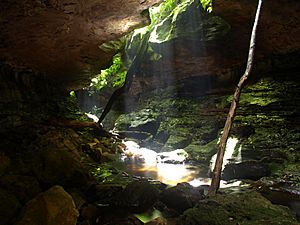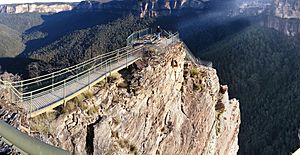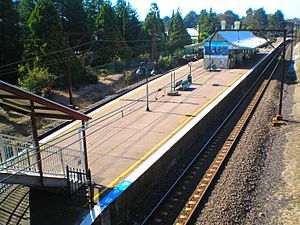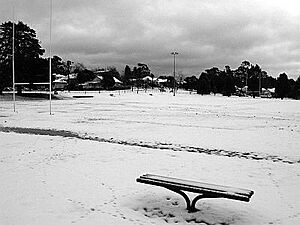Blackheath, New South Wales facts for kids
Quick facts for kids BlackheathNew South Wales |
|||||||||||||||
|---|---|---|---|---|---|---|---|---|---|---|---|---|---|---|---|

Town centre
|
|||||||||||||||
| Population | 4,479 (2021 census) | ||||||||||||||
| Established | 1815 | ||||||||||||||
| Postcode(s) | 2785 | ||||||||||||||
| Elevation | 1,066 m (3,497 ft) | ||||||||||||||
| Location |
|
||||||||||||||
| LGA(s) | City of Blue Mountains | ||||||||||||||
| State electorate(s) | Blue Mountains | ||||||||||||||
| Federal Division(s) | Macquarie | ||||||||||||||
|
|||||||||||||||
|
|||||||||||||||
Blackheath (postcode: 2785) is a lovely town in the Blue Mountains of New South Wales, Australia. It's located high up, about 1,065 meters above sea level. You can find it between the towns of Katoomba and Mount Victoria.
Blackheath is about 120 kilometers west-north-west of Sydney. It's also 11 kilometers north-west of Katoomba and 30 kilometers south-east of Lithgow.
This town is known for its lively art scene. It hosts two markets every month: the Blackheath Growers Market and The Blackheath Community Market. There are also special Christmas and antique markets. You can find many community activities here, like the Blackheath Philosophy Forum, which started in 2002. It arranges public talks about philosophy and other interesting topics.
Over the years, Blackheath has grown, and more shops have opened. Some of the shops that were built in the late 1800s are still standing today.
Contents
A Glimpse into Blackheath's Past
The land around Blackheath was once a special summer meeting place. Different Aboriginal groups, like the Darug, Gundungurra, and Wiradjuri nations, would gather here for important ceremonies called corroborees.
After Europeans settled in Australia, this area was first called Hounslow. In 1815, Governor Lachlan Macquarie crossed the Blue Mountains. When he returned, he renamed the spot "Black-Heath." He chose this name because of the dark color and rough feel of the local plants. He wrote in his journal that the place had a "black wild appearance."
The very first building in Blackheath was the "Scotch Thistle Inn." Andrew Gardner built it in 1831. Even the famous scientist Charles Darwin visited this inn in 1836! The land Gardner was given back then is still visible today. It's the area between the Great Western Highway, Govetts Leap Road, and Gardiners Crescent.
Blackheath really started to grow into a town after the Main Western railway line was built in 1869. The current train station was finished in 1883. A big dam was built to provide water for the steam trains. Later, this dam became public swimming baths. The baths opened for swimming in 1931. Since then, they have been updated with new pools and play areas. Blackheath's first post office opened in 1910, but now it's a clothing shop.
Blackheath has a cool sports story too! In November 1931, the famous cricketer Don Bradman played a social match here. He scored a century (100 runs) in just three overs for the Blackheath team against Lithgow. He ended up scoring 256 runs! Today, Blackheath Oval is home to the local cricket team.
Important Historic Sites
Blackheath has several places that are listed for their historical importance. These are called heritage-listed sites. They include:
- Blue Mountains National Park: Many Blue Mountains walking tracks are part of this park.
- Main Western railway: The Blackheath railway station is also a heritage site.
Who Lives in Blackheath?
| Historical population | ||
|---|---|---|
| Year | Pop. | ±% |
| 1921 | 2,182 | — |
| 1933 | 1,427 | −34.6% |
| 1947 | 2,349 | +64.6% |
| 1954 | — | |
| 1961 | — | |
| 1966 | 2,077 | — |
| 1971 | 2,228 | +7.3% |
| 1976 | 2,371 | +6.4% |
| 1981 | 3,027 | +27.7% |
| 1986 | 3,599 | +18.9% |
| 1991 | 3,749 | +4.2% |
| 1996 | 4,119 | +9.9% |
| 2001 | 4,047 | −1.7% |
| 2006 | 4,177 | +3.2% |
| 2011 | 4,353 | +4.2% |
| 2016 | 4,265 | −2.0% |
| 2021 | 4,479 | +5.0% |
| Source: Australian Bureau of Statistics data. | ||
In 2021, about 4,479 people lived in Blackheath. Here are some interesting facts about them:
- Age Groups: The average age of people living here was 53 years old. This is older than the national average of 38 years. About 13.6% of the population were kids under 15. This is a bit less than the national average of 18.2%.
- Where People are From: Most people (73.0%) were born in Australia. The next biggest group (6.9%) was born in England. About 87.8% of people spoke only English at home.
- Homes in Blackheath: Most homes in Blackheath (96.2%) are separate houses. On average, about 2 people live in each home.
- Beliefs: Many people (51.9%) said they had no religion. Other common beliefs were Anglican (11.5%) and Catholic (12.7%).
Fun Places to Visit
Blackheath is surrounded by amazing natural beauty. It has many lookouts and walking tracks.
Govetts Leap Lookout
Just a short drive from Blackheath town center is Govetts Leap. This lookout offers amazing views of the Grose Valley and its beautiful waterfalls. The waterfall is named after William Romaine Govett. He was an assistant to the Surveyor General and found the falls in June 1831. The word 'leap' is an old Scottish word for a waterfall.
Evans Lookout
Evans Lookout is another great spot for stunning views. It also looks out over the Grose Valley.
Other Lookouts and Adventures
There are other cool lookouts like Pulpit Rock, Perrys Lookdown, and Anvil Rock. These are located north-northeast of town, off Hat Hill Road. From these lookouts, you can start many different walks. There are short paths for quick views, longer walks that take half or a whole day, and even multi-day hikes with camping. People who enjoy canyoning and rock climbing also come to Blackheath. The famous Blue Gum Forest can be reached from Perrys Lookdown.
The area is also famous for its colorful flowers in spring. In autumn, the leaves turn golden as the weather gets cooler. In September, you'll see daffodils blooming everywhere. On the first weekend of November, Blackheath hosts its yearly Rhododendron Festival.
The Campbell Rhododendron Gardens are a must-see. They are north-northeast of the town center on Bachante Street. These large gardens (18.5 hectares) have many rhododendrons and azaleas. They grow under the shade of native Australian trees. Volunteers from The Blue Mountains Rhododendron Society of NSW take care of them.
The beautiful cherry trees that line the streets usually bloom fully in the first week of October.
Mount Boyce lookout is to the northwest of Blackheath, on the way to Lithgow. You can also get to the Megalong Valley from Blackheath. It's about 18 kilometers away to the west, past Mount Victoria.
Blackheath has many cafes and restaurants, a big antique center, and other shops. It's a popular place for people from Sydney to visit on weekends. Because of its cool climate, Blackheath is a favorite spot for "Christmas in July" celebrations.
The Rhododendron Festival
One of Blackheath's biggest events is the Rhododendron Festival, often called the 'Rhodo' Festival. It happens on the first Sunday of November. This festival celebrates the blooming of the Rhododendron Tree. European settlers planted many of these trees in Blackheath, especially in the Blackheath Soldiers Memorial Park and the Campbell Rhododendron Gardens. The festival includes a fun parade and stalls from local businesses. This date also marks the opening weekend of the Blackheath Pool.
Getting Around Blackheath
Blackheath got its train connection in 1869. Today, the Blackheath railway station is on the Blue Mountains Line.
The Great Western Highway is the main road into town. It runs right through Blackheath's main shopping area. To the northwest, near Mount Victoria, the Darling Causeway connects the Great Western Highway to the Bells Line of Road. There have been ideas to upgrade the Great Western Highway west of Blackheath with a tunnel. However, in 2024, the tunnel project was put on hold.
In 2016, most people traveled to work by car (56.6%). About 12.7% worked from home, and 5.4% took the train.
Blue Mountains Transit runs two bus routes through Blackheath:
- 698: From Katoomba to Blackheath
- 698V: From Katoomba to Mount Victoria
Local Animals
Many different animals live in and around Blackheath. You might see mammals like the Eastern Grey Kangaroo and Echidna in the forests.
Rare bird species also live here. These include the Lesser Sooty Owl and the beautiful Regent Honeyeater.
Blackheath's Weather and Location
Blackheath is known for its amazing views. From Evans Lookout and Govetts Leap in the east, you can see the Grose Valley. To the west, past the small village of Shipley, Hargraves Lookout offers views of the Megalong Valley.
As the highest town in the Blue Mountains, Blackheath often gets snow in winter. On average, it has two good snowfalls each season. Even in summer, the temperatures are usually mild compared to other places at the same latitude.
In winter, the average highest temperature is about 9 to 10 degrees Celsius. Some days, it might not even get above 5 or 6 degrees Celsius. Frosts are common but not as strong as in places further west. The local landscape helps keep the lowest temperatures around -3 to 5 degrees Celsius. This is because the coldest air flows down into the valleys on clear, calm nights.
In summer, the average highest temperature is around 23 degrees Celsius. But sometimes, it can reach 30 degrees Celsius in mid-summer. Temperatures can also drop to the mid-teens or lower when cold air comes from the south. The lowest temperatures in summer are usually around 10 to 15 degrees Celsius. However, single-digit lows can happen, especially in December. In December 2011, it even got down to 2.4 degrees Celsius!
Blackheath is on a high ridge, which means it can get very strong winds. These are especially common in winter when cold fronts move up from the Southern Ocean. On July 5, 2011, a strong cold front brought winds that officially gusted up to 139 kilometers per hour. This caused many trees to fall and damaged some properties. The shape of the cliffs and valleys can make winds even stronger in certain spots. Strong winds are more likely from April to November. Summer storms can also bring strong winds, usually around 70 to 90 kilometers per hour.
Blackheath can also have fogs and thunderstorms, but this changes each year. Some summer days are quite humid, which can lead to severe storms that last for hours. Thunderstorms are common in spring and summer. This is often because the lower air heats up quickly in the morning due to the town's high elevation.
Blackheath is surrounded by the Blue Mountains National Park. This area can be prone to bushfires. In November 2006, serious bushfires threatened Blackheath from the north.
Blackheath has a subtropical highland climate. This means average monthly temperatures don't drop below -3 degrees Celsius or go above 25 degrees Celsius. Blackheath gets over 1000 millimeters of rain each year on average.
| Climate data for Mount Boyce AWS (1990–2020); 1,080 m AMSL; 33.62° S, 150.27° E | |||||||||||||
|---|---|---|---|---|---|---|---|---|---|---|---|---|---|
| Month | Jan | Feb | Mar | Apr | May | Jun | Jul | Aug | Sep | Oct | Nov | Dec | Year |
| Record high °C (°F) | 38.0 (100.4) |
38.0 (100.4) |
32.5 (90.5) |
27.9 (82.2) |
26.3 (79.3) |
23.0 (73.4) |
17.4 (63.3) |
20.7 (69.3) |
27.6 (81.7) |
29.3 (84.7) |
35.5 (95.9) |
37.5 (99.5) |
38.0 (100.4) |
| Mean daily maximum °C (°F) | 24.4 (75.9) |
23.0 (73.4) |
20.6 (69.1) |
17.3 (63.1) |
13.6 (56.5) |
10.1 (50.2) |
9.6 (49.3) |
11.3 (52.3) |
14.8 (58.6) |
17.9 (64.2) |
20.4 (68.7) |
22.8 (73.0) |
17.2 (62.9) |
| Mean daily minimum °C (°F) | 13.5 (56.3) |
13.2 (55.8) |
11.4 (52.5) |
8.8 (47.8) |
6.1 (43.0) |
3.8 (38.8) |
2.6 (36.7) |
3.0 (37.4) |
5.4 (41.7) |
7.7 (45.9) |
9.8 (49.6) |
11.7 (53.1) |
8.1 (46.5) |
| Record low °C (°F) | 4.5 (40.1) |
3.8 (38.8) |
2.9 (37.2) |
−0.9 (30.4) |
−2.2 (28.0) |
−3.0 (26.6) |
−3.4 (25.9) |
−3.6 (25.5) |
−3.6 (25.5) |
−1.5 (29.3) |
0.2 (32.4) |
2.4 (36.3) |
−3.6 (25.5) |
| Average precipitation mm (inches) | 118.1 (4.65) |
138.6 (5.46) |
117.5 (4.63) |
63.9 (2.52) |
52.1 (2.05) |
77.7 (3.06) |
41.4 (1.63) |
53.8 (2.12) |
54.6 (2.15) |
67.7 (2.67) |
99.8 (3.93) |
81.4 (3.20) |
966.6 (38.07) |
| Average precipitation days | 16.1 | 16.2 | 17.0 | 14.4 | 12.6 | 15.0 | 14.2 | 11.9 | 11.3 | 13.5 | 16.5 | 16.2 | 174.9 |
| Average afternoon relative humidity (%) | 58 | 66 | 65 | 63 | 69 | 72 | 69 | 59 | 56 | 54 | 61 | 57 | 62 |






